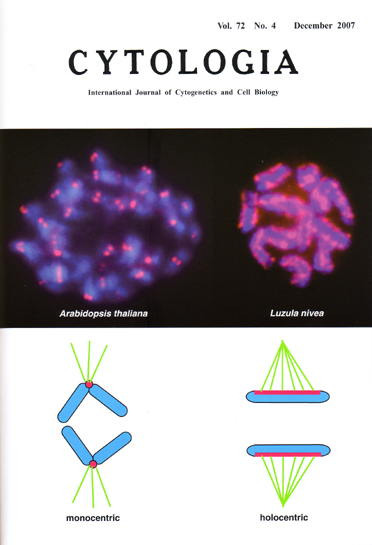| ON THE COVER |  |
|---|---|
| Vol. 72 No.4 December 2007 | |
| Technical note | |
|
|
|
| Monocentric and holocentric chromosomes in plants The centromeres is a special region of eukaryotic chromosomes for spindle attachment and chromatid cohesion. Chromosomes can be classified into two types according to centromere localization monocentric and holocentric. A monocentric chromosome hasa limited centromere size, which appears as a primary constriction on the chromosome. In a monocentric chromosome, spindle microtubules attach to the centromcre and bring the chromosome to the pole at anaphase with the centromere leading (Bottom left). In contrast, a holocentric chromosome possesses a centromere whose size is almost thesame as the chromosome, and has no primary constriction. Microtubules become attached to almost the entire region of the chromosome and, as a result, the chromosomes move as a linear bar toward the pole (Bottom right). Luzula species have been known to possess holocentric chromosomes for 60 years. However, no one had ever been able to observe the real shape of the centromeres. Recently, Nagaki et al. (The Plant Cell, 17, 1886-1893, 2005) identified a centromere specific histone H3 (CENH3) from the snowy woodrush L. nivea (LnCENH3), and visualized the protein using an antibody against LnCENH3 (Top Right). This study clearly revealed that the centromeres of L. nivea appear in the linear-shape at prophase to telophase, and cover almost all lengths of the chromosomes. Interestingly, the amount of LnCENH3 decreased significantly at interphase. This sort of CENH3 distribution is quite contrary to that of Arabidopsis thaliana, possessing monocentric chromosomes (Top Left). The Arabidopsis chromosome image was obtained from the cultured cells having variable chromosome numbers (Shibata and Murata, Journal of Cell Science 117, 2963-2970, 2004). (Kiyotaka Nagaki and Minoru Murata, Research Institute for Bioresources, Okayama University, Kurashiki 710-0046, Japan) |
|